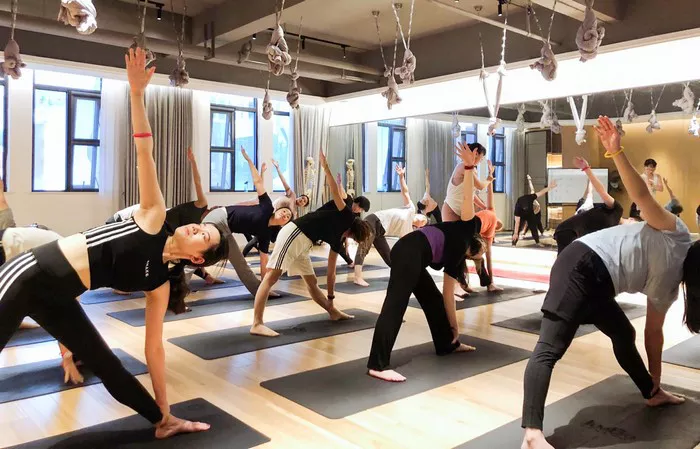Restorative yoga is gaining popularity in today’s fast-paced world as individuals seek solace from stress and rejuvenation for the mind, body, and spirit. As more people recognize the profound benefits of this gentle, healing practice, the demand for qualified restorative yoga teachers is on the rise. If you’re passionate about promoting relaxation and holistic wellness, becoming a restorative yoga teacher could be a fulfilling career path. Here’s a comprehensive guide to help you embark on this journey:
1. Cultivate a Personal Practice
Before aspiring to teach restorative yoga, it’s crucial to develop a deep understanding of the practice through personal experience. Dedicate time to explore various restorative yoga poses, breathing techniques, and relaxation methods. Immerse yourself in the practice, attending classes, workshops, and retreats led by experienced teachers. This firsthand experience will not only deepen your practice but also provide invaluable insights into teaching methodologies and effective cueing.
2. Deepen Your Knowledge
Expand your understanding of restorative yoga by delving into its philosophical and theoretical foundations. Study the principles of relaxation response, nervous system regulation, and mindfulness-based stress reduction. Familiarize yourself with the therapeutic benefits of each restorative pose, including their effects on the physical, mental, and emotional levels. Additionally, acquire knowledge of anatomy, physiology, and biomechanics relevant to the practice to ensure safe and effective teaching.
3. Complete a Teacher Training Program
Enroll in a reputable restorative yoga teacher training program to receive comprehensive instruction and guidance from experienced facilitators. Look for programs accredited by Yoga Alliance or other recognized yoga organizations to ensure quality education and certification. A typical teacher training curriculum covers topics such as restorative yoga principles, sequencing, prop usage, hands-on adjustments, teaching methodology, and ethics. Choose a program that aligns with your schedule, budget, and learning preferences, whether it’s an intensive residential training or a part-time course spread over several months.
4. Practice Teaching
Gain practical teaching experience by leading restorative yoga sessions for friends, family, or colleagues. Start with small groups or private sessions to refine your teaching skills, pacing, and communication techniques. Encourage feedback from your students to identify areas for improvement and tailor your teaching approach accordingly. As you gain confidence and proficiency, consider offering donation-based or community classes to reach a wider audience and build your teaching portfolio.
5. Hone Your Observation Skills
Develop keen observation skills to assess students’ needs, limitations, and progress during restorative yoga sessions. Pay attention to their breath patterns, body alignment, and facial expressions to gauge their level of relaxation and comfort. Learn to offer appropriate modifications, variations, and props to accommodate individual differences and enhance their experience. Cultivate empathy, patience, and non-judgmental awareness to create a supportive and inclusive learning environment for all students.
6. Embrace Continued Learning
Stay updated with the latest developments and trends in restorative yoga by attending workshops, seminars, and conferences regularly. Explore advanced techniques, specialized modalities, and interdisciplinary approaches to enrich your teaching repertoire. Seek mentorship from seasoned restorative yoga teachers or collaborate with healthcare professionals to deepen your understanding of therapeutic applications and interdisciplinary integration. Embrace lifelong learning as an integral part of your journey as a restorative yoga teacher.
7. Cultivate Your Teaching Style
Discover your unique teaching voice and style by integrating your personal insights, experiences, and values into your restorative yoga classes. Experiment with different teaching methodologies, themes, and sequences to offer diverse and engaging sessions for your students. Develop effective communication skills, including clear instructions, mindful language, and compassionate presence, to facilitate a nurturing and transformative experience. Cultivate authenticity, vulnerability, and humility as you share the gift of restorative yoga with others.
8. Build Your Professional Network
Connect with fellow restorative yoga teachers, yoga studios, wellness centers, and community organizations to expand your professional network and opportunities for collaboration. Join online forums, social media groups, and professional associations dedicated to restorative yoga to stay connected with like-minded individuals and exchange resources, ideas, and support. Attend networking events, retreats, and teacher gatherings to foster meaningful relationships and potential teaching opportunities in your local and global yoga community.
9. Obtain Certification and Insurance
Once you’ve completed your teacher training program and accumulated sufficient teaching experience, pursue certification as a registered yoga teacher (RYT) through Yoga Alliance or other relevant organizations. Fulfill the required continuing education hours and adhere to the ethical standards and guidelines set forth by the certifying body. Additionally, invest in liability insurance to protect yourself and your students in the event of unforeseen accidents or injuries during your restorative yoga classes.
10. Launch Your Teaching Career
Embark on your journey as a certified restorative yoga teacher by offering regular classes, workshops, retreats, and private sessions in your local community or online platform. Create a professional website, social media presence, and marketing materials to promote your services and attract potential students. Collaborate with complementary healthcare providers, wellness professionals, and corporate clients to offer specialized programs and expand your reach. Stay committed to your personal growth, teaching excellence, and the well-being of your students as you inspire others to embark on their own path of restorative healing through yoga.
Conclusion
In conclusion, becoming a restorative yoga teacher requires dedication, passion, and a commitment to lifelong learning and personal growth. By cultivating a deep understanding of the practice, honing your teaching skills, and embracing your unique voice and style, you can make a meaningful impact on the well-being of others and contribute to the growing community of restorative yoga practitioners worldwide.
FAQs:
How long does it take to become a Kundalini yoga teacher?
Becoming a certified Kundalini yoga teacher typically requires completing a Kundalini yoga teacher training program, which can vary in duration. These programs may range from intensive residential trainings lasting a few weeks to part-time courses spread over several months. Generally, you can expect to spend anywhere from 200 to 500 hours in training, depending on the level of certification you seek and the requirements of the training provider.
How do I turn my yoga into a career?
To turn your yoga practice into a career, start by deepening your knowledge and skills through advanced training and certification programs. Establish a consistent teaching schedule by offering classes at local studios, gyms, community centers, or online platforms. Build a strong online presence through a professional website, social media, and digital marketing to attract students and promote your services. Explore opportunities for additional revenue streams, such as workshops, retreats, private sessions, and teacher training programs. Cultivate relationships with other professionals in the wellness industry and seek mentorship from experienced teachers to support your career growth.
Is 30 too old to become a yoga teacher?
No, 30 is not too old to become a yoga teacher. Many people embark on their yoga teaching journey later in life and find it to be a rewarding and fulfilling career path. Age is not a barrier to pursuing your passion for yoga and sharing it with others. What matters most is your dedication, commitment, and enthusiasm for the practice. Whether you’re 30 or older, you can become a certified yoga teacher by completing a teacher training program, gaining teaching experience, and continuously deepening your knowledge and skills. Embrace your journey with an open heart and a willingness to grow, and you’ll find that age is merely a number on your path to becoming a yoga teacher.
















